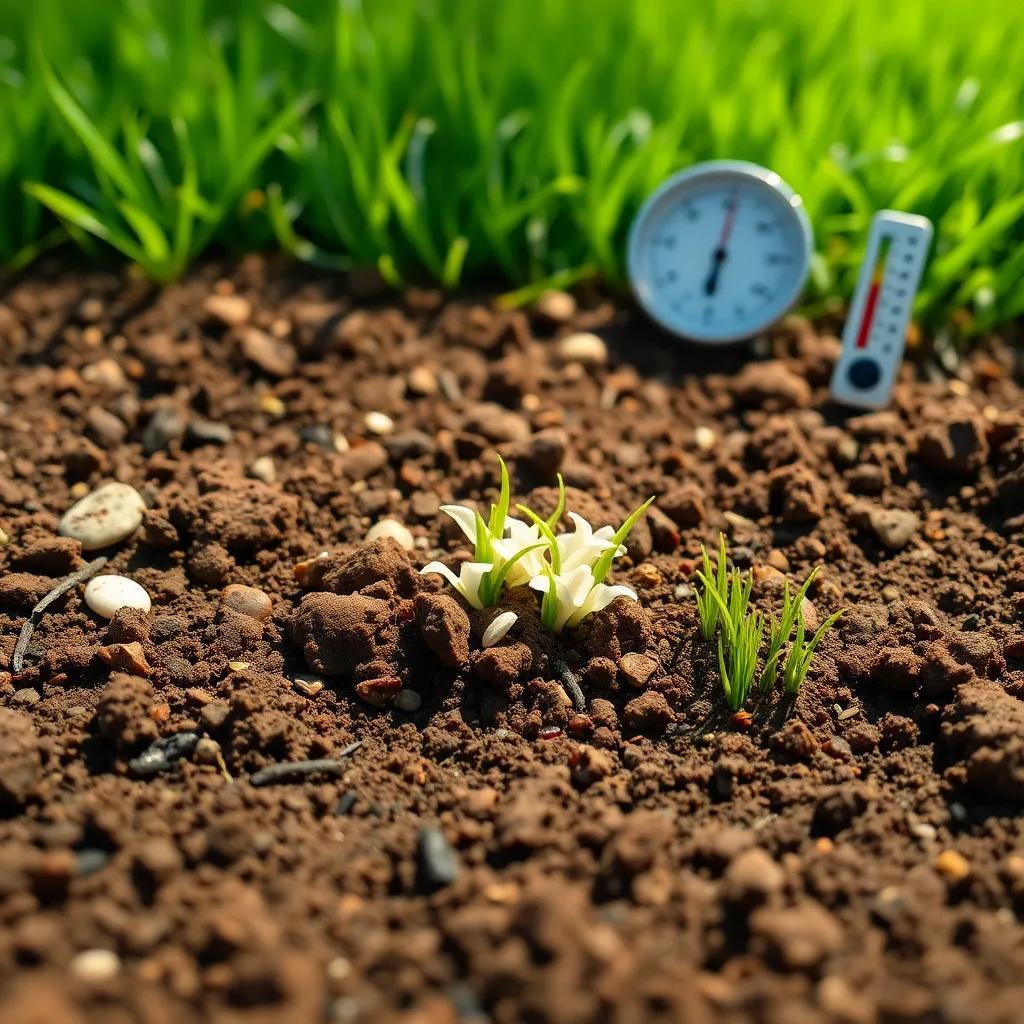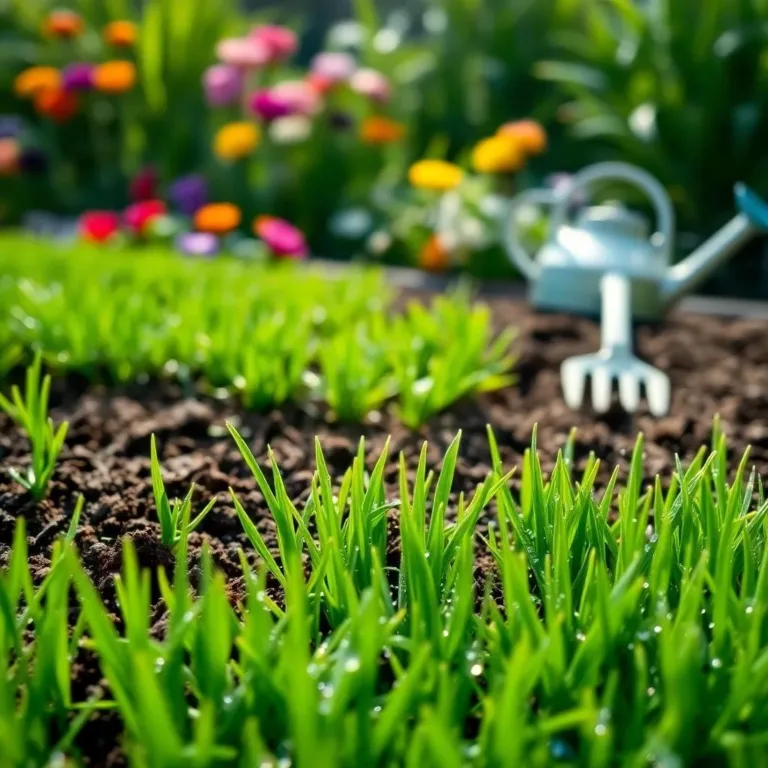Are you dreaming of a lush, green lawn that makes your neighbors green with envy? If so, you’re in the right place! In this article, I’ll share everything you need to know about perennial ryegrass, from its speedy germination to tips for keeping it thriving. Let’s turn that grassy dream into a reality!
Understanding Perennial Ryegrass Characteristics
Hey there, fellow gardening enthusiast! Let’s chat about perennial ryegrass and why it might just become your new best friend in the garden. First of all, this grass is often the superhero of lawns because it grows so quickly! That’s right—if you want a lush, green yard in no time, perennial ryegrass is the way to go.
So what makes this grass so special? For starters, it’s a cool-season grass, which means it thrives when things are a bit chilly. This makes it perfect for those of us who live in areas with colder winters but enjoy mild summers. It loves those cooler temperatures, and guess what? It can stay green and lively even when the heat hits!
Here are a few cool characteristics of perennial ryegrass:
- Speedy Growth: It germinates quickly, usually in just 5 to 10 days. That’s like waiting for a pizza delivery—only way better!
- Dense Turf: This grass creates a thick lawn that can handle foot traffic. So, if you have kids or pets running around, this grass can take a beating and bounce back like a champ!
- Aesthetic Appeal: With its fine texture and vibrant green color, perennial ryegrass adds a touch of beauty to any landscape. Who wouldn’t want a stunning yard?
Now, let’s get to the good stuff. Not only does this grass look great, but it’s also helpful for the environment! It helps with erosion control, making it perfect for those sloped areas where soil likes to sneak away. Plus, it competes against weeds beautifully. So, while you’re enjoying your new lawn, you’ll be keeping those pesky weeds at bay!
Are you ready to dive into the next big chapter of how to help this grass germinate faster? Trust me, you’ll want to keep the momentum going!
Factors Influencing Germination Speed
Alright, let’s talk about what makes perennial ryegrass tick when it comes to germination. There are several factors at play, and knowing them will make you a grass-growing wizard! The speed of germination isn’t just about tossing some seeds on the ground and hoping for the best. Nah, we need to give these seeds the VIP treatment!
Here’s what to pay attention to:
- Soil Temperature: This is a biggie! Perennial ryegrass loves cooler soil temps between 50°F and 65°F. If it’s too cold, it might just take a nap instead of sprouting. Too warm? That’s a no-go too! It’s like finding the perfect temperature for your hot cocoa—just right!
- Moisture: Keeping the soil consistently moist is key. Think of it like watering your houseplants. You want to give them a drink, but you don’t want to drown them! Try to avoid puddles.
- Seed Quality: Just like you wouldn’t bake with old, expired ingredients, you don’t want to use old seeds! Make sure you get high-quality seeds from a trusted source. Fresh seeds are more likely to sprout quickly!
- Light Exposure: This grass prefers to be in the dark a bit when germinating. So, when you plant your seeds, make sure they’re covered. It helps them feel cozy and ready to grow!
- Seed-to-Soil Contact: Get those seeds snuggled in nicely with the soil. Properly preparing the seedbed—removing debris and loosening the ground—ensures your seeds have the best chance to sprout!
By keeping these factors in mind, you’ll create a welcoming environment for your perennial ryegrass to germinate quickly. And let’s be honest—who wouldn’t want a fast-growing, lush lawn? So roll up those sleeves and let’s get those seeds sprouting!

Typical Germination Timeframe for Perennial Ryegrass
So, you’ve planted those perennial ryegrass seeds, and now you’re eagerly waiting to see the first signs of life! The typical germination timeframe for this grass is generally between 7 to 14 days, provided everything is set just right. You might be wondering, “What if I don’t see sprouts after a week?” Don’t worry! A little patience is key in this process.
Factors like soil temperature, moisture levels, and even the quality of the seeds can influence how quickly you see those beautiful green blades popping up. Here’s a breakdown of what you can expect:
- Days 1-4: After planting, the seeds will start to absorb moisture. This is when they’re waking up—sort of like hitting the snooze button on a Monday morning!
- Days 5-10: You might notice some tiny sprouts emerging. This part is so exciting! The seeds are growing roots, which helps anchor them in the soil.
- Days 11-14: If the conditions were ideal, your lawn should start looking green and vibrant by now. More grass blades will appear, creating that lovely dense turf we all dream about.
Remember, not every seed is going to sprout at the same time, and that’s totally normal! If you keep the soil moist and at the right temperature, you’ll see fantastic results. It’s like nurturing a little garden miracle, and trust me, the payoff is worth the wait!
Techniques to Promote Faster Germination
Want to fast-track the germination of your perennial ryegrass? I’ve got some simple yet effective techniques to help you achieve that lush lawn faster! Think of these tips as your secret weapons in the garden—ready to give your seeds a boost! Here’s how to get started:
- Prepare the Soil: Start with a clean canvas! Remove any weeds, rocks, or debris. Loosening the soil creates a cozy nest for your seeds. A little TLC goes a long way!
- Soak the Seeds: Give your seeds a quick soak for 12 to 24 hours before planting. This softens their outer layer and kickstarts the germination process. Think of it as a spa day for your seeds!
- Overseeding: If you have an existing lawn that looks a bit tired, overseeding can help! Spread those ryegrass seeds to fill in thin patches. The established grass provides shade and moisture, making it a perfect environment for new growth.
- Use a Seed Germination Aid: Try adding a seed starter mat or blanket. These handy tools help retain moisture and provide warmth, giving your seeds a warm hug right after they’re planted!
- Water Consistently: Keep the soil damp but not soggy. I like to use a light misting spray to keep things just right. It’s like a gentle rain shower for your grass!
By implementing these techniques, you not only help your seeds germinate faster, but you also set the stage for a vibrant and healthy lawn. Just remember, with a bit of effort and care, those seeds will reward you with a stunning, green paradise!
Maintaining Optimal Conditions for Successful Growth
Once your perennial ryegrass has germinated and started growing, you want to keep those little green blades happy and healthy! Maintaining optimal conditions is key to ensuring your lawn flourishes. Let me break it down for you with some friendly advice!
- Watering: After germination, continue to keep the soil consistent in moisture. Water lightly but often until the grass is well established. As the grass grows, you can gradually decrease watering frequency. Think of it like training for a marathon—start slow and build up!
- Soil Health: Make sure your soil is rich in nutrients. Consider applying a light layer of fertilizer designed for new grass. Just a little sprinkle can help boost those growth rates and keep your lawn looking lush.
- Mowing: Once your grass reaches about 3 inches in height, it’s time for a trim! Mowing encourages denser growth and prevents your grass from getting too tall and floppy. Who doesn’t want a neatly manicured lawn?
- Weed Control: Keep an eye out for pesky weeds. Regularly pulling them out by hand or using a safe herbicide can prevent them from competing with your beautiful ryegrass.
- Monitoring: Check on things regularly. Look for dry patches or areas that need extra love. Maybe it’s time for a little extra water or a fertilizer boost!
By keeping these practices in mind, you can support your perennial ryegrass in its quest for a vibrant existence. With a little ongoing care and attention, you’ll have a lush, thriving lawn that you can enjoy all season long! Happy gardening!

